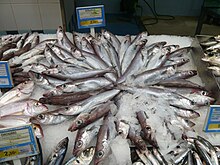Blue whiting
| Blue whiting | |
|---|---|

| |
| Scientific classification | |
| Domain: | Eukaryota |
| Kingdom: | Animalia |
| Phylum: | Chordata |
| Class: | Actinopterygii |
| Order: | Gadiformes |
| Family: | Gadidae |
| Genus: | Micromesistius |
| Species: | M. poutassou
|
| Binomial name | |
| Micromesistius poutassou (A. Risso, 1827)
| |

| |
| Range of blue whiting | |
| Synonyms | |
The blue whiting (Micromesistius poutassou) one of the two species in the genus
A related species, southern blue whiting, Micromesistius australis, occurs in the Southern Hemisphere.
Fisheries
Exploitation of blue whiting only started in the 1970s. The species, in the last decades, has become increasingly important to the fishing industries of northern European countries, including Russia. Catches exceeded 1 million tonnes from 1998 to 2008.
For 2012, ICES advised the catches should be no more than 391,000 tonnes (385,000 long tons; 431,000 short tons).[8] This large increase relative to the quota in 2011 (but not to the catches in 1998–2008) is caused by a revision in the stock assessment; however, recruitment to the stock is still low and the stock is forecasted to decline. The coastal states set the total quota for 2012 to 391,000 tonnes.[9]
The fish is usually not marketed fresh, but processed into fish meal and oil. However, in Russia, southern Europe, and Japan, blue whiting are sometimes sold as food fish.
Management
Blue whiting in the northeast Atlantic is a
Quota advice for blue whiting in the northeast Atlantic is provided by ICES. For a long period, blue whiting fisheries were mainly regulated through nationally set quotas because there was no international agreement about sharing the total quota;[11] consequently, the total catch greatly exceeded the advised quotas[3] However, the Coastal States (the Faroe Islands, the European Union, Iceland and Norway) reached an agreement in December 2005,[12] ending the period of what was sometimes referred to as "Olympic fishing". Since 2006, the blue whiting fishery has been regulated under this agreement, which gives the greatest share to the European Union, but through quota swaps, Norway has been holding the largest annual quotas.

References
- ISBN 9780120261192.
- ^ "Handling and Processing Blue Whiting". Archived from the original on 2010-05-01. Retrieved 2008-04-06.
- ^ a b c ICES Advice 2010: Blue whiting in Subareas I–IX, XII, and XIV (Combined stock) Archived August 12, 2011, at the Wayback Machine
- ^ The State of World Fisheries and Aquaculture 2008
- S2CID 59376591.
- ^ Agreed Record of Conclusions of Fisheries Consultations between the Faroe Islands, the European Union, Iceland and Norway on the Management of Blue Whiting in the North-East Atlantic in 2011
- ^ Final Catch figures Blue whiting 2011
- ^ ICES Advice September 2011. Blue whiting in Subareas I–IX, XII, and XIV (Combined stock) Archived April 2, 2012, at the Wayback Machine
- ^ Agreed Record of Conclusions of Fisheries Consultations Between Iceland, the European Union, the Faroe Islands and Norway on the Management of Blue Whiting in the North-East Atlantic in 2012
- ^ "Straddling stocks". Archived from the original on 2015-06-03. Retrieved 2011-08-20.
- .
- ^ Press release: Broad agreement on fisheries between Norway and the EU
External links
- FishBase
- Blue whiting: playing a big game with small fish
- Northeast Atlantic blue whiting. Chapter 11 in Life-cycle spatial patterns of small pelagic fish in the Northeast Atlantic. ICES Cooperative Research Report 306, 2010
- The Marine Flora and Fauna of Norway: Blue whiting (with photographs of living blue whiting!)
